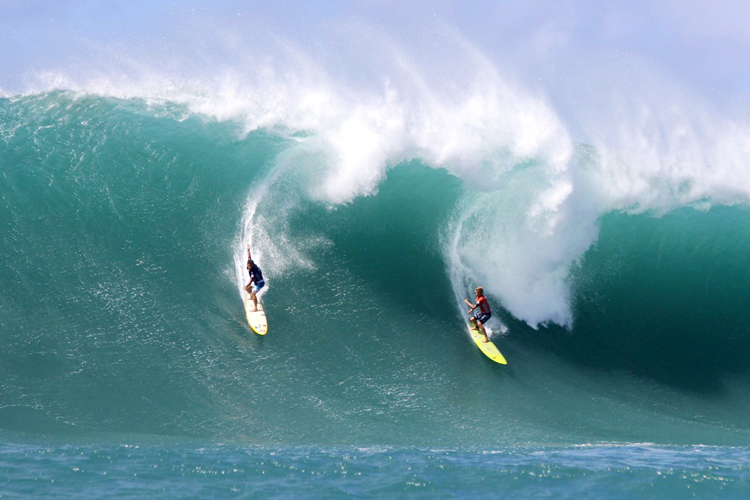The history of surfing has a unique entry for Waimea Bay. The famous Hawaiian surf site is considered the dawn of big wave riding.
Waimea Bay is a legendary surf spot located on the North Shore of Oahu.
It is a hectic and dangerous place during winter and a quiet portrait of the Hawaiian ocean life during summer.
Welcome to "The Bay," a surf break known for its mammoth waves and death-defying rides.
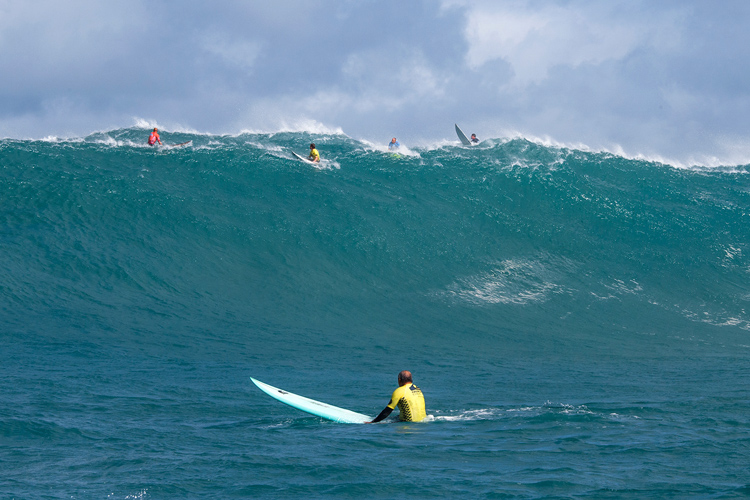
The Surf Spot
The waves break in front of Waimea Bay Beach Park, just 300 yards west of Kamehameha Highway.
The world-renowned big wave surf spot comes to life during Hawaiian winter (November to April) when long-period, deep water NW swells suddenly hit the local lava shelf located 100 meters off of the northern headland.
A classic big wave surfing day at Waimea Bay traditionally gets from good to great during medium tide and with light ESE trade winds.
Waves in the 20-foot plus Hawaiian scale always attract dozens of local and foreign swell hunters eager to stamp their mark and authority in this historical surfing location.
The Waimea Bay wave is known for testing surfers' eagerness to stamp airdrop take-off skills, but it is also known for its choppy slopes and heavy whitewater mountains.
If you're lucky enough to escape these rolling beasts, you will still have to face the famous shore break with its pound lips.
Paddling in and out is extremely tricky, and the rip currents are powerful, so surfers need to time their movements between sets to avoid obliteration.
The shoreline is also tricky because it drops off quickly from shallow to 20-foot-plus deep waters.
Waimea Bay is a spectator-friendly big wave surfing spot.
When the surf's up at Waimea Bay, fans and media professionals can easily witness and capture the intensity of the breaking waves from a close distance.
During high surf warnings, waves might roll past the rocks and boulders and reach the roadside above.
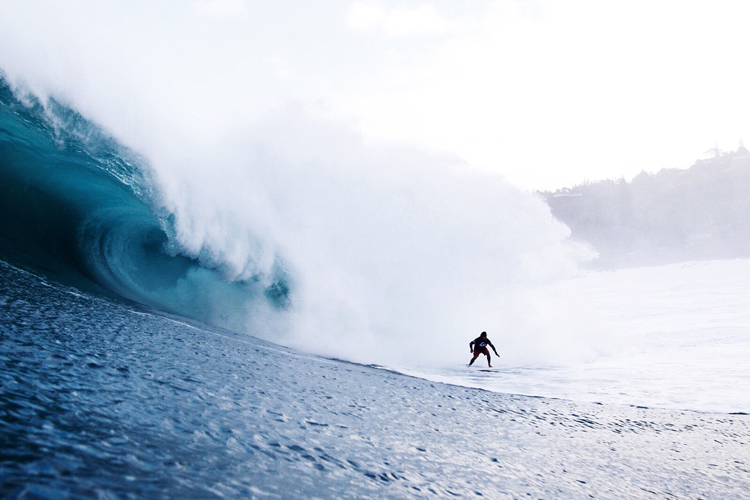
The Waimea River Wave
There's a time in the year when the Waimea River reaches its maximum capacity, breaks through the sandy beach, and flows into the sea.
To accelerate the process, local surfers use hands and shovels to dig up the sand and connect the river mouth to the Waimea shore break.
The goal is to create a path for the water to flow and, more importantly, to create one of the largest stationary waves in Hawaii.
The waves can be ridden for several hours, and the man-made phenomenon attracts thousands of non-surfers and tourists.
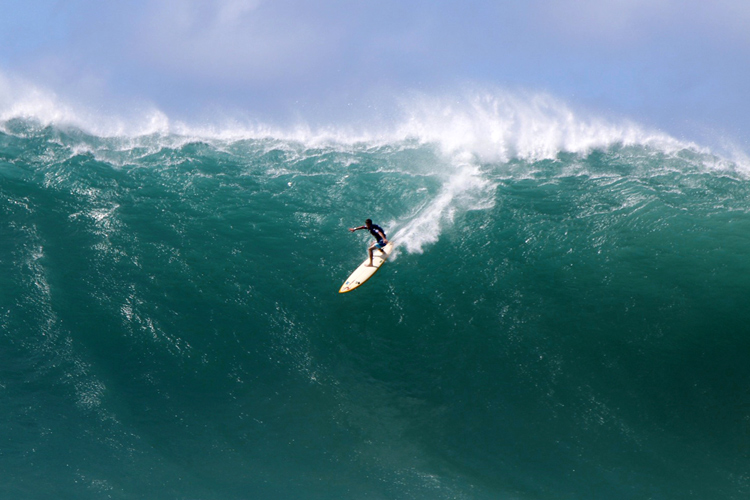
The History of Waimea Bay
Waimea - meaning "reddish water - was the first place on the island of Oahu where foreigners contacted Native Hawaiians.
After Captain James Cook was killed at Kealakekua Bay on February 14, 1779, his ships Discovery and Resolution anchored at the Bay for water.
The second group of haoles arrived in 1793 aboard Daedalus, Captain George Vancouver's chartered merchant ship.
While filling their barrels with water, two of them were killed by Hawaiians who wanted their weapons.
In 1894, a flood devastated Waimea Valley and destroyed the Hawaiians' houses, and the community was dramatically downsized.
C. W. Winstedt built the Kamehameha Highway from Waimea to Kahuku in 1932.
For many years, Waimea Bay was considered too dangerous to be surfed.
The spot was first ridden in the 1950s and opened a new chapter in the history of the sport. Big wave surfing is now viewed as a discipline in its own right, in part due to Waimea Bay's reputation.
On one winter day in 1957, Greg Noll (pictured below) and a few surf buddies paddled out in 15-foot conditions. Bud Browne was filming from dry land.
"We caught a few waves and didn't get sucked down a vortex, nothing ate us, and that was that. That was not a big day, but there were some hairy days to come," Noll said in the movie "Riding Giants."
From the 1970s to the 1990s, the beloved extreme surf spot became the ultimate exhibition playground for big wave performers.
Today, like in the past, Waimea Bay still is a dangerous place for advanced riders and one of the most popular surfing beaches of Oahu's Seven-Mile Miracle.
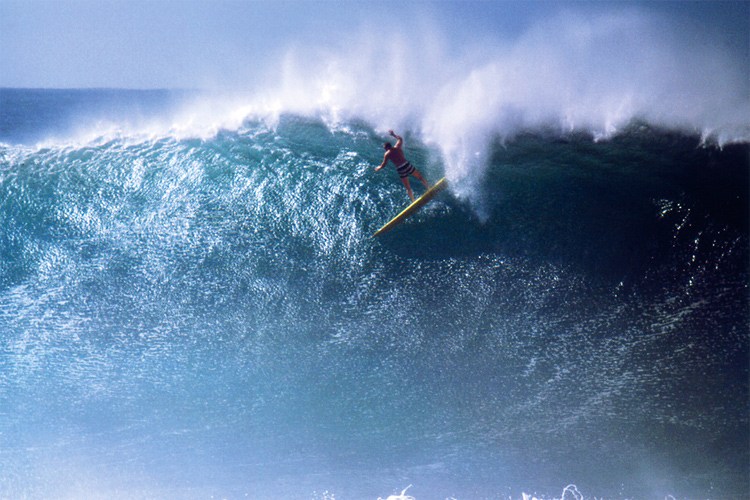
The Eddie Aikau Memorial
The spirit of Waimea Bay can also be felt at Beach Park grounds, where the Eddie Aikau Memorial pays tribute to the fallen angel.
The plaque encrusted in a rock reads:
Eddie Aikau disappeared at sea on March 17, 1978, while going to get help for the crew of the Polynesian Voyaging Society's double hull canoe - Hokule'a.
The canoe capsized in rough seas about 20 miles off Oahu during the night of March 16, 1978.
Eddie Aikau is gone, but his name will live in the annals of heroism of Hawaii.
His spirit will live, too, wherever the Hokule'a sails and on the beach at Waimea Bay where, as a City and County lifeguard, he saved thousands of lives from the dangerous waters.
This was a great man, a great Hawaiian, and he will live in our hearts forever.
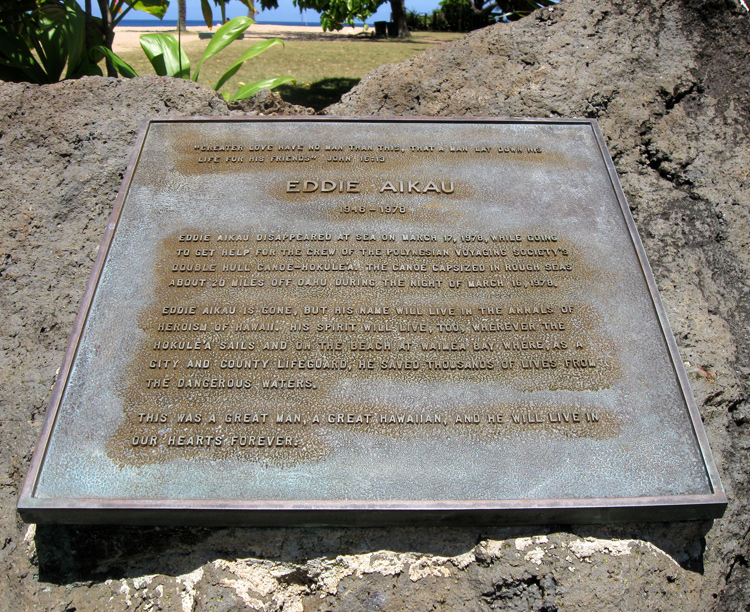
The Eddie Aikau Invitational
The Eddie Aikau Invitational is a surf contest that honors the life of Hawaiian legend and hero Eddie Aikau.
The prestigious event was run for the first time in 1985 and only gets the green light when waves hit the 20-foot range.
That's why "The Bay calls the day."
When the surf's up at Waimea Bay and the contest begins, spectators are not allowed to get anywhere near the water.
Lifeguards will put a yellow line from one end of the beach to the other to keep people away from the dangerous shore break.
To earn a spot in the famous competition, the invitees and alternates must prove their skills in extreme surfing arenas and earn respect from their peers.
To participate and get a ticket to ride The Eddie is to honor the values of the Hawaiian iconic - courage, positivity, and humbleness.
Tragedy at Waimea Bay
On December 22, 1943, Woody Brown, 31, drove across the island to the North Shore with his 17-year-old high school surfer-friend Dickie Cross (pictured below, left, alongside Wally Froiseth).
At Sunset Beach, the duo decided to paddle out in what appeared to be 10-to-12-foot surf. But when they reached the line-up, they realized it was too big.
As they were trying to get back to shore, an outgoing current in the channel forced Brown and Cross to paddle three miles west to Waimea Bay.
Forty-five minutes later, approaching Waimea, Cross was caught by a breaking wave and lost his board.
The set kept coming, and Dickie began swimming toward Brown and shouting for help.
But Brown was also in survival mode. He shoved his board away and got pounded by several humungous waves.
Exhausted, he began to swim for the beach and put himself in the path of the next two or three sets to tumble forward and reach the sand.
Woody Brown was pulled out of the water by a group of soldiers who had spotted him from the highway.
But Dickie Cross disappeared, and his body was never found.
Greg Noll would describe the episode as the "Waimea Taboo," which kept surfers out of this place until 1957.
Waimea Bay is a wave of consequences.
In 1995, an up-and-coming California surfer named Donnie Solomon got caught inside on a medium-sized day at The Bay.
Despite being an accomplished wave rider, the young talent paddled out where Hawaiian surfer Kawika Stant was dropping in.
But, because he didn't want to bail in front of his fellow surfer, Donnie tried to duck dive the massive wall of water in front of him.
Solomon went over the falls and never resurfaced. When lifeguards and jet ski drivers found him, it was already too late, and he could not be resuscitated.
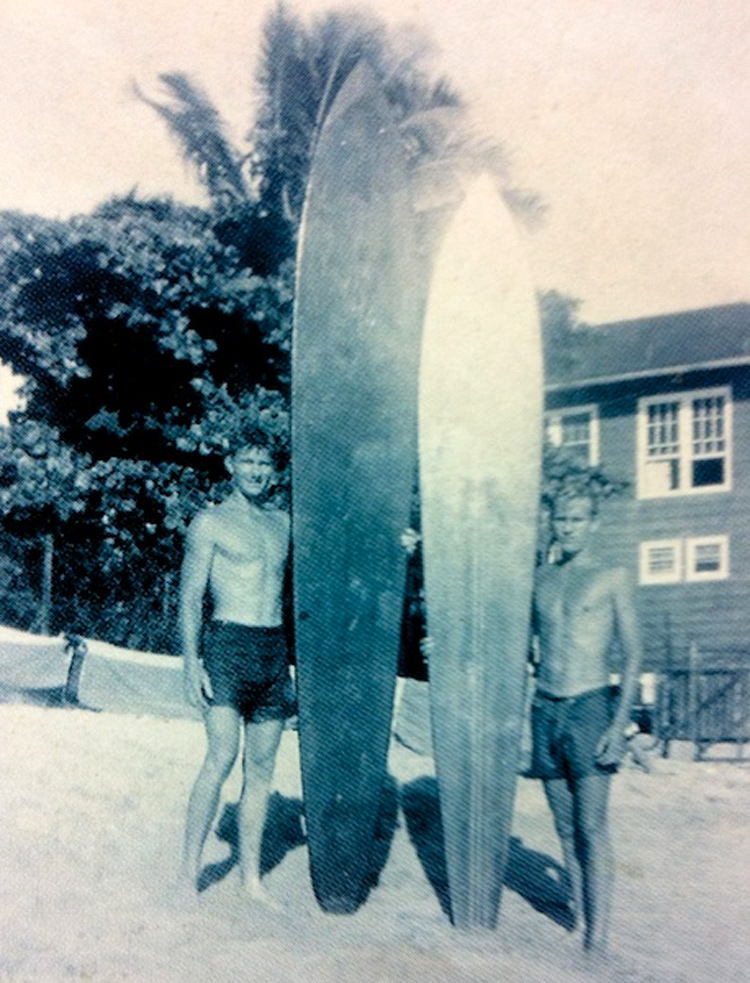
The Waimea Bay Jumping Rock
For those who aren't afraid of heights, there's an exciting challenge in the surroundings - the Waimea Bay rock jump.
It's a distinctive landmark that sits at the entrance of the water on the southern side.
So, despite the "no jumping" sign, if you're into huge leaps of faith into warm waters, "Da Big Rock" will provide you with your daily dose of adrenaline rush.
All you need to do is climb the 25-foot cliff located on the far left side of the Bay, opposite Mission of Sts. Peter and Paul Church on the north side.
When you reach the top, take a deep breath and jump into the transparent waters.
But beware: climbing the rock can be slippery. When you get there, make sure there's no one swimming below before jumping off "The Rock."
If you're not into high cliff jumps, explore the several underwater tunnels located underneath the jump site.
The main tunnel is located close to the shore and can be reached after a five-second swim through a mysterious cave.
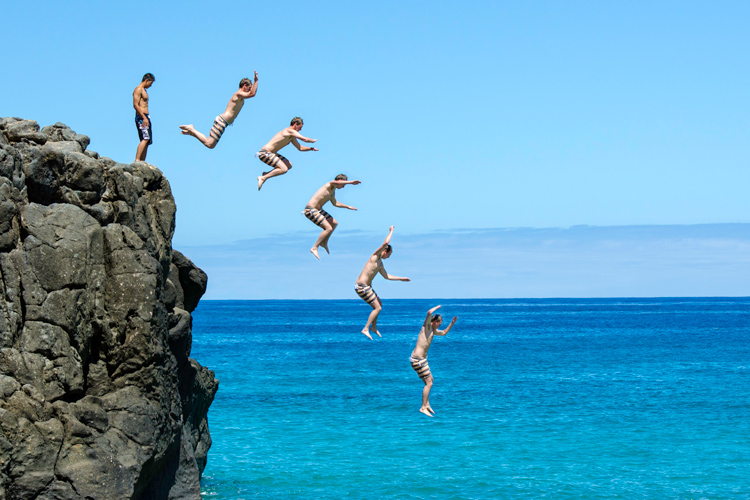
Waimea Bay: Non-Surfing Attractions
There are a lot of things you can do at Waimea Bay if you're not a surfer or if the ocean's flat.
You can always park your car, enjoy a meal with friends and family at the picnic bench tables available in the area, and relax on the vast nearby lawn area or under the shady trees.
The spot features showers and restrooms and is always supervised by fully trained and certified lifeguards.
During summer and calm water days, if you're into hook-and-line fishing, swimming, diving, and snorkeling, Waimea Bay will keep you entertained for several hours.
If you prefer, simply walk along the golden sandy beach and enjoy the surrounding natural beauties and breathtaking sunsets.
Across the road from Waimea Bay, you'll find the Waimea Valley, a stunning botanical garden with over 5,000 varieties of flora and sacred archaeological sites.
There's also the magnificent Waimea Falls and its walking trail that will always impress locals and tourists alike.
The Pu'u o Mahuka Heiau State Monument is a historical site and also the largest temple in the archipelago.
Ancient Hawaiians believed that Pele, the goddess of volcanoes, leaped from this point in Oahu to the next island, Molokai.
The "Hill of Escape" covers covering two acres (8,100 square meters) on a hilltop overlooking Waimea Bay and still features the original outlying walls.
